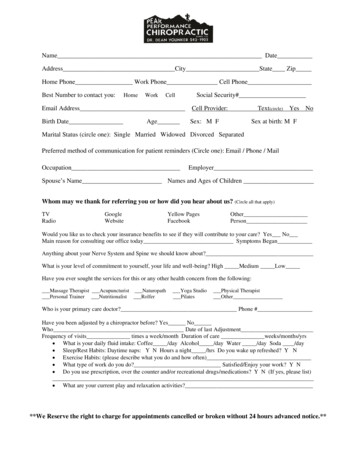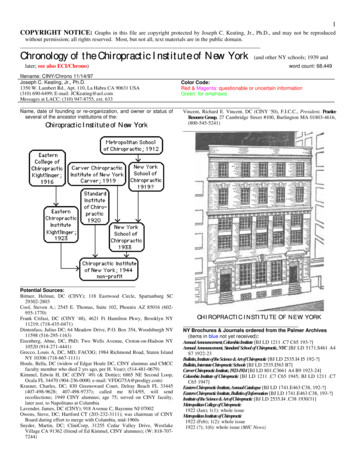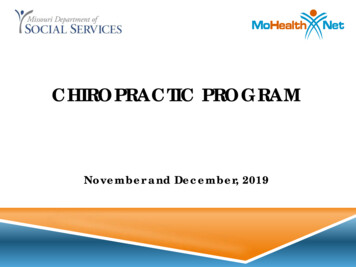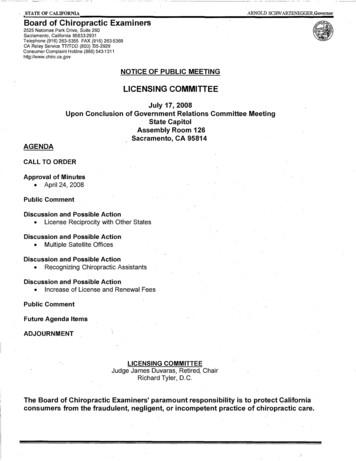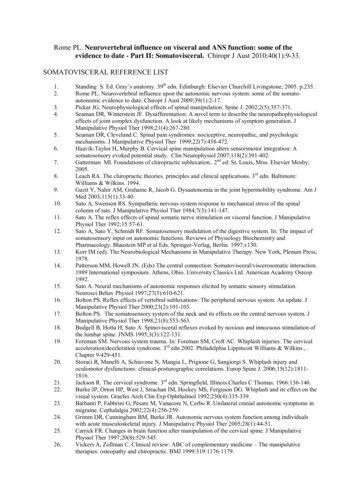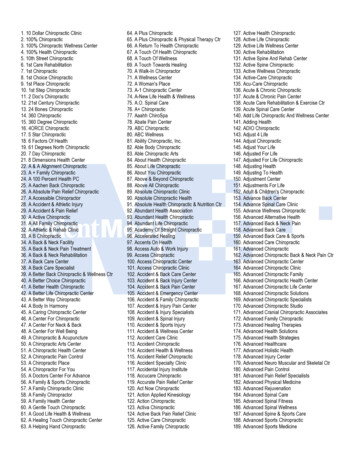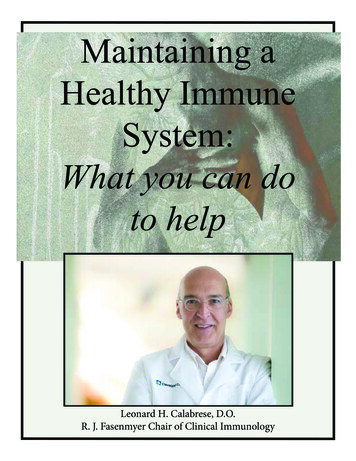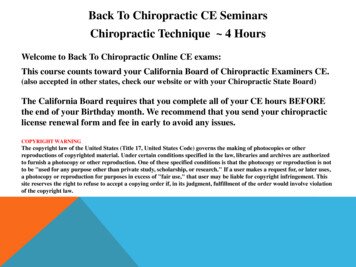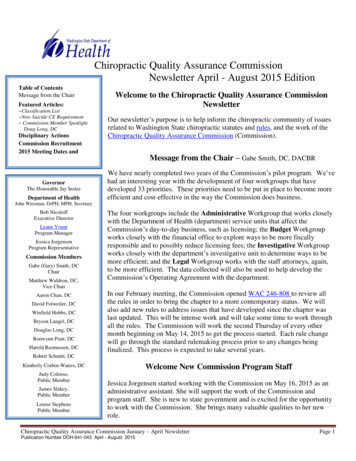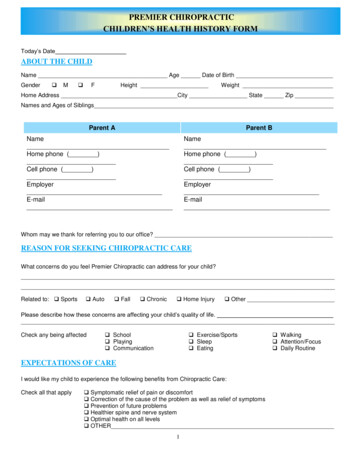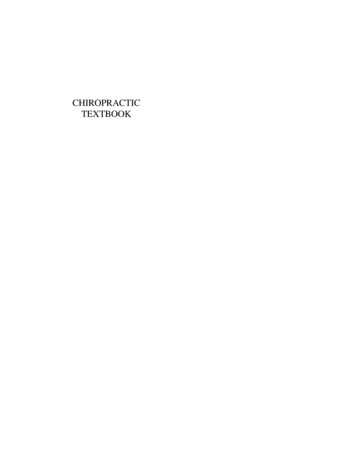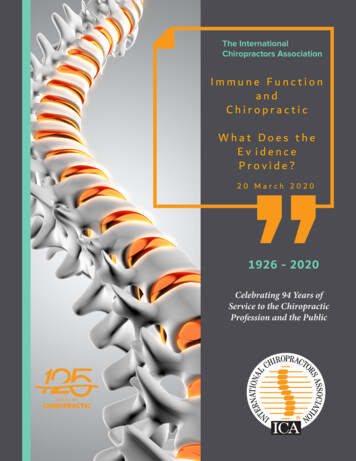
Transcription
The InternationalChiropractors AssociationImmune FunctionandChiropracticWhat Does theEv idenceProvide?20 March 20201926 - 2020Celebrating 94 Years ofService to the ChiropracticProfession and the Public
Immune Function and Chiropractic – What Does theEvidence Provide?Introduction“Scientific advances are predicated on new knowledge that is robust and reliable and thatserves as a solid foundation on which further advances can be built.” [1]Evidence and observation have since the inception of caregiving driven the decisionmaking of care givers. As caregiving became medicine, and now has evolved into healthcare, experts in health research have established a methodology known as evidence-basedmedicine or evidence-based health care to describe the ideal process of clinical decisionmaking by health care professionals. Almost simultaneous to this was the promotion ofmeta-analysis and systematic reviews as methods of gathering the evidence on a topic anddrawing quality conclusions. One of the great challenges with the promotion of systematicreview has been the almost singular focus on examining randomized controlled trials andeliminating all other peer reviewed published studies from the pool of papers to beevaluated. In fact, one paper cited in this report started with a body of evidence of morethan 1,300 articles and eliminated all but 8 to use in their systematic review.David L. Sackett, the modern founder of Evidence-Based Health provided clarity to theintention. An evidence-based practice, “ aims at integrating individual clinical expertisewith the best available external clinical evidence from systemic research and patientvalues.[2]Every day, a million times a day, chiropractors make evidence-informed decisions withtheir patients. As a result, about a million times a day, safe, effective chiropractic care isprovided world-wide.
Page 2 of 15 - Immune Function and Chiropractic“Medicine is the study of disease and whatcauses man to die.Chiropractic is the study of health and whatcauses man to live.”Dr. B.J. PalmerFounder of the InternationalChiropractors AssociationCOVID-19 and the Need for ResearchStanford researcher, John P.A. Ioannidis stated, “The current coronavirus disease, Covid19, has been called a once-in-a-century pandemic. But it may also be a once-in-a-centuryevidence fiasco. At a time when everyone needs better information, from disease modelersand governments to people quarantined or just social distancing, we lack reliableevidence “. [3]The Coronavirus-19 Global Pandemic, the need for fact-based, peer reviewed information,and the International Chiropractors Association (ICA) affirmation to the globalchiropractic community that subluxation-based chiropractic practice is scientific andevidence-based, brings together several key points:1.Research is essential to improving access to chiropractic as displayed in therecently completed 10 year chiropractic study by the US Department of Defensewhich confirmed that chiropractic to improve key fitness characteristics amongactive duty service personnel with low back pain and could lead to improve militaryreadiness in such individuals.[4] As a result TRICARE is looking to expand accessto chiropractic.2. There is an urgent need to expand significantly the level of research fundingavailable to US chiropractic institutions for basic and clinical research.3. Many chiropractic peer reviewed publications are not PubMed Indexed and need tobe for ease of information gathering both inside and outside the chiropracticcommunity.4. A lack of research evidence is not proof of a lack of benefit.
Page 3 of 15 - Immune Function and ChiropracticCoronavirus 19 (COVID-19) is so New there is No CredibleScientific Evidence to Support any Type of TreatmentAs of March 2020, there are no cures for COVID-19accepted in the scientific community. There are norecognized cures in conventional medicine or alternativehealth approaches for COVID-19. There are novaccines, no drugs, no natural remedies, no alternativetherapies that have been tested and the outcomes peerreviewed to meet any credible evidence-based standardin science. This includes chiropractic.The ICA has previously provided clear reminders to its members of the importance of notadvertising in any form the suggestion that chiropractic can cure, treat, prevent, or mitigateCOVID-19 because the evidence to substantiate such a claim does not exist.The evidence does not exist because the research on COVID-19 and chiropractic has notbeen conducted, just as it has not been conducted on most other treatment options thatmight be considered as potentially helpful or for potential ‘off label use’. At present thereare 44 clinical trials registered with clinicaltrials.gov for COVID-19. Not even one is forany non-drug, non-biologic approach. Answers for scientific questions never askedthrough research will never be answered with any credibility.If Chiropractic Cannot Cure or Prevent, COVID-19,Then Why Talk Immune Function?The conversation about immune function is bigger than just COVID-19 infection alone.The ICA has been clear that no claims can be made about COVID and chiropractic.The conversation that all the experts in public health have been promoting is to use everymeans available to support one’s immune system during the pandemic. (Adequate sleep,good nutrition, frequent hand washing with soap, etc.) There are other factors to consideras well. For example, the stress every member of the public, first responders, and healthcare professionals are feeling as a result of the changes in our everyday lives from theglobal pandemic. This stress is creating unprecedented levels of anxiety, and fear in some.Scientific evidence has validated that long-term exposure to stress negatively effects theimmune system.The issue of anxiety and stress has become so prevalent that the Centers for Disease Controland Prevention (CDC) and the National Institutes of Health (NIH) have begun promotinginformation to the public. From the CDC’s website “Stress during an infectious diseaseoutbreak can include:
Page 4 of 15 - Immune Function and Chiropractic Fear and worry about your own health and the health of your loved onesChanges in sleep or eating patternsDifficulty sleeping or concentratingWorsening of chronic health problemsIncreased use of alcohol, tobacco, or other drugsAmong the recommendations to support oneself through the stress includes, ‘take care ofyour body’.[5] “Psychological conditions, such as stress or depression, are known tocompromise immune defenses and increase the likelihood of infections.”[6]Wayne Jonas, MD in his book, How Healing Works, wrote about the principles ofhealing, “In condition after condition, system after system, and person after person, Ifound three common factors that induced healing:(1) the rituals that helped a person have a meaningful experience,(2) the support of the whole person, and(3) the regular stimulation of a biological response.The specific treatments and agents used varied by person, culture, theory, and place, butthe processes were the same. Whole systems science showed us that a person is anecosystem – more like a garden to be cultivated than a car to be fixed.”[7]Chiropractic supports the whole person. Vitalistic chiropractors address more thanjust the mechanics of the spine.“While other professions are concerned with changingthe environment to suit the weakened body,chiropractic is concerned with strengthening the bodyDr. B.J. Palmerto suit the environment.”Immune Function“The overall function of the immune system is to prevent or limitinfection The immune system can distinguish between normal, healthycells and unhealthy cells by recognizing a variety of "danger" cues calleddanger-associated molecular patterns (DAMPs). Cells may be unhealthybecause of infection or because of cellular damage caused by non-infectiousagents like sunburn or cancer. Infectious microbes such as viruses andbacteria release another set of signals recognized by the immune systemcalled pathogen-associated molecular patterns (PAMPs) When theimmune system first recognizes these signals, it responds to address theproblem. If an immune response cannot be activated when there is sufficientneed, problems arise, like infection. On the other hand, when an immune
Page 5 of 15 - Immune Function and Chiropracticresponse is activated without a real threat or is not turned off once thedanger passes, different problems arise, such as allergic reactions andautoimmune disease.The immune system is complex and pervasive All immune cells come fromprecursors in the bone marrow and develop into mature cells through aseries of changes that can occur in different parts of the body.”[8]Two Pillars of the Immune System The Immune system is built upon two pillars – theinnate immunity and adaptive immunity (sometimes referred to as acquired immunity.[912]Innate Immunity is the nonspecific first line of defense in our immune system. Innatehas not been sensitized by external actions such as previous infections of vaccinations. Itis not stimulated by specific antigens.Adaptive Immunity, sometimes referred to as acquired or specific immunity is a subsetof the immune system that develops very specialized responses as a result of exposure topathogens. The system creates immunological memory to create an enhanced response toprotect if the same pathogen exposure happens at a subsequent time. The adaptiveimmune system sometimes has challenges distinguishing between harmful and harmlessforeign molecules, which is associated with conditions such as hay fever or seasonalallergies.What is measured to study immune function? Researchers conducting scientificinvestigation start with a theory or hypothesis and determine what can be measured togather valid information to answer whether the theory or hypothesis has merit. In lookingat immune function, the below are a snapshot of measurements that are used in research tomeasure related to immunity.1.T-lymphocytes (T-cells) are often used in studies to evaluate the immuneresponse.[5] T-Cells are “important players in the adaptive arm of the immune system.”Because the central nervous system (CNS) is an immune-privileged site, immune responsein the CNS are relatively restricted. The unique nature of the communication between theCNS and the immune system can be observed, for example, in the dialog between the CNSan T-cells.”[13]2.“Chemokines are chemotactic cytokines that control cell migration and cellpositioning throughout development, homeostasis, and inflammation. The immune system,which is dependent on the coordinated migration of cells, is particularly dependent onchemokines for its function. Not only do chemokines guide immune effector cells to sitesof infection or inflammation, but they also coordinate interactions between immune cells.By doing so, chemokines promote interactions between the innate and adaptive immunesystems, thus shaping and providing the necessary context for the development of optimaladaptive immune responses.”[14]
Page 6 of 15 - Immune Function and Chiropractic3.Neuropeptides expression has been studied extensively. More than 10,000 papershave been published as a result. Neuropeptides are short sequences of amino acids thatfunction either directly or indirectly to modulate synaptic activity. In addition,neuropeptides may also function as primary neurotransmitters.[15] Recent researchfindings point to the role of “neuropeptide in immune functions”[6]4.Substance P (SP) is a neuropeptide that is released from sensory nerve endings andis widely present in nerve fibers. SP acts on bones and related tissues by binding toreceptors, thereby regulating bone metabolism, cartilage metabolism, and fracture healing.SP, a signaling substance, is recognized by both the immune system and the nervoussystem.[16]5.Cytokine interleukin 2 (IL 2) is pivotal in T-cell dependent immune responses.There are well established protocols to utilize IL 2 assessment to study ability of T-cell tobecome activated.[17]Chiropractic and the Nervous SystemA professional librarian conducted a systematic literature of seven databases. Only 18controlled studies were evaluated based on the a priori criteria. The effects of highvelocity, low amplitude spinal manipulation were evaluated. An association between thespinal manipulation and the autonomic nervous system was confirmed through multiplemeasurers. The authors noted a need for high-quality studies that include patients, wellcharacterized for pain duration and outcome measure baseline values and address therelation between changes in neurophysiology and pain.[18]In a study of 21 young men with cervical pain and shoulder stiffness but withoutabnormalities in neck-to-shoulder MR images and without history of any prior treatmentswere evaluated. An MRI examination of the neck to shoulder area was conducted on allpatients. The MR images were used as a reference for the anatomical locations of cervicalmuscles in the PET imaging. After spinal manipulation, PET imaging was conducted,cervical muscle tension was measured bilaterally at the superior part of the trapeziusmuscle using a tissue hardness meter and the mean value of three measurements wererecorded. Salivary amylase levels were also measured for each subject using an amylasemonitor to evaluate changes in autonomic nervous system (ANS) function.The researchers “observed metabolic changes in the brain and skeletal muscles, as well asreductions in subjective pain, muscle tension, and salivary amylase, after spinalmanipulation intervention. These results may be associated with reduced sympatheticnerve activity, suggesting that spinal manipulation induces a kind of relaxation similar tothat achieved by biofeedback. The brain response to spinal manipulation may reflect thepsychophysiological relaxation that accompanies reduced sympathetic nerve activity.[19]
Page 7 of 15 - Immune Function and ChiropracticA 2005 basic science review of chiropractic summarized the state of the science in severalareas including the nervous system response to chiropractic spinal manipulation. Thereview confirmed that between 1997 and 2005 the basic science body of evidenceconfirming a relationship between chiropractic spinal manipulation and the central nervoussystem. They concluded, basic science studies support chiropractic theory that spinalsubluxation and spinal manipulation impact neurologic function. In addition, theinterdependence of nervous, endocrine, and immune systems has been discussed here.These studies suggest mechanisms by which spinal influences may mediate a clinicallysignificant impact on immune function [20]The Nervous System and the Immune SystemThe Nervous System and the Immune System Cross-Talk “Considerable evidence hasmounted to support active communication between the nervous system and the immunesystem. The nervous system, including the brain and the peripheral divisions can eitherstimulate or inhibit various activities of both the innate and adaptive immune systems.Conversely, the immune system, through the release of cytokines, can influence the activityof the nervous system. Several excellent reviews have addressed the subjects of nervousand immune system “cross-talk” in great detail. Very recently, however, several peptides,recognized initially for their neural or neuroendocrine signaling functions have been shownto exhibit potent antimicrobial activity. This discovery signals the possibility that thenervous system, through utilization of these peptides, has the capacity to deliver antiinfective agents directly to innervated sites localized with great spatial specificity anddelivered rapidly. The nervous and neuroendocrine systems, in principle, have the potentialto serve a direct immune function.”[21]The aforementioned Cramer, et. Al, 2005 review notes, “The central nervous system andimmune system share modulator and receptor mechanisms by which the two systemscommunicate. Their interaction maintains both basal and stress-related homeostasisthrough two major pathways: the systemic sympathetic nervous system (SNS) andhypothalamic-pituitary-adrenal (HPA) axis. The immune system is now thought to be‘tuned’ by contrasting neural influences When internal or external influences disturbhomeostasis, both the SNS and HPA axis are activated, thereby increasing the peripherallevels of catecholamines and glucocorticoids to restore the steady state of the internalmilieu. The review notes the most extensive body of science regarding chiropractic and theimmune system at the time was by Brennan. Two noted findings were that that a singlespinal manipulation “enhanced polymorphonuclear cell activity that was associated with aslight, but statistically significant, rise in plasma substance P.” In another study they foundpatients presenting with neuromusculoskeletal complaints had reduced numbers ofcirculating natural killer cells; but these cells were not functionally impaired.[20]A 2018 article reporting on the study design of clinical trial designed to provide knowledgeregarding the underlying mechanisms of the effects of Spinal manipulation provided thefollowing analysis of the evidence: “Chiropractic care including spinal manipulativetherapy (SMT) has been found to be a safe, effective and cost-effective non-invasive
Page 8 of 15 - Immune Function and Chiropractictreatment for some types of spinal pain. SMT has both local and regional pain reducingeffects as well as central nervous system effects such as a general reduction of painsensitivity. SMT is thought to decrease pain by mechanically affecting muscular and jointfunction (i.e. normalizing muscle tone and improving joint mobility). However, recentexperimental research has suggested that SMT may also be influencing the incoming/ascending pain signals (local nociceptive input affecting dorsal horn excitability ortemporal summation) and/or the excitability of the central pain regulating mechanisms. Asystematic review concluded that short-term sympathetic upregulation can be found withSMT, regardless of the spinal area being treated. This raises the question of whether thepain reducing effect of SMT is associated with a modulation of autonomic nervous system(ANS) activity.”[22]Scientific EvidenceChiropractic, Spinal Manipulation, and AdjustmentICA is issuing this report and will continue adding to this list of studies that may be ofinterest to our members and the greater chiropractic community at large. The followingstudies include a review of the literature on the effects of spinal adjustment (manipulation)on immune function. The list also includes those studies in which biomarkers which alsoplay a role in immune function are studied.1.Neuroimmunomodulation and a Possible Correlation with MusculoskeletalSystem Function From 1989 – “There is an increasing body of evidence that the nervoussystem is capable of modulating the immune response. Receptors for neuromodulators andneurohormones have been found on human T lymphocytes. Activation of these receptorscan be stimulatory or inhibitory depending on the neuroactive substance. The immunesystem may be able to communicate with the nervous system using neuromodulators andneurohormones secreted by lymphocytes. Sympathetic innervation of lymphoid tissues isnot restricted to blood vessels and smooth muscle, but directly supplies lymphocytes andblood precursor cells. It is theorized that spinal fixations may adversely affect the immuneresponse through somatosympathetic reflexes. Spinal manipulation can correct the spinalfixations and may eliminate the adverse effects of somatosympathetic reflexes.”[23]2.A Literature Review sought to determine the effects of spinal manipulation onbiochemical markers in humans and establish the level of evidence for changes inbiochemical biomarkers. Spinal Manipulation (SM), defined as a high-velocity, lowamplitude thrust technique. Among the outcome measured sought were neuropeptides(neurotensin, oxytocin, SP) (2) inflammatory (TNF, IL) and (3) endocrine (cortisol,epinephrine, nor-epinephrine, leutinizing hormone) biomarkers from any body fluids(blood/urine/saliva). After removal of duplications, 1217 citations were screened. That wasculled down to 96 abstracts screened, 45 full-text articles were assessed for eligibility. Anda total of 8 trials included in the review.
Page 9 of 15 - Immune Function and ChiropracticThe review found the studies varied in study design, quality, and outcomes. The conclusionafter the review was that a moderate level of evidence existed in the eight studies whichfound that spinal manipulation influences various biomarkers typically identified as onesnot only involved in pain perception/modulation but also play an important role ininflammation, tissue healing and immune response. Studies in the review found that SpinalManipulation influences various biochemical markers. Spinal Manipulation can increaseSubstance P, neurotensin, oxytocin and interleukin levels and may influence cortisol levelspost-intervention.[24]3.Low Back Pain and the production of Chemokines. In a study evaluating therole of inflammation in nonspecific low back pain, an assessment of the production ofmigratory nociceptive chemokines, and sE-selectin (which activates endothelial cellproduction) in patients with acute and chronic low back pain before and after spinalmanipulation with a single high velocity low amplitude manipulative thrust to the involvedsegment in the lumbosacral region was conducted. Six adjustments were provided over aspan of two weeks with the single thrust and no other additional treatment modalities. The3-armed study was completed by 19 patients with acute low back pain; 23 with chroniclow back pain; and 21 asymptomatic volunteers.There were differences in mediators both within their own start and finish measures as wellas between groups. Researchers documented significant differences existing in the levelsof the studied chemokines between low back pain patients and the asymptomatic controls.Several of the chemokines studied were significantly augmented in acute low back painpatients when compared to the control patients. The production of one of the measuredchemokines, CCL4, was significantly higher in the acute low back pain patients than thechronic low back pain patients at baseline, while the other measurements were notsignificantly different. Conversely, while the plasma content of sE-selectin variedsomewhat between groups, compared with controls, the levels were not significantlydifferent in the acute low back pain group but were significantly elevated in the chroniclow back pain group. The outcomes after the two-week intervention period found that themean chemokine production declined across the board in both groups of low back painpatients while remaining essentially unchanged in the asymptomatic group. The spinalmanipulation protocol had no statistically significant effect on the sE-selectin productionwhich remained significantly elevated in chronic low back pain patients and unchanged inthe acute patients. This is the first step in evaluating the effect of chiropractic onchemokines and sE-selectin and what the changes may or may not mean in relation to boththe inflammatory markers and immune system function. One of the still unansweredquestions is whether the decline in certain chemokines production after spinal manipulationproduces an immune response that provides a statistically significant level of protectionagainst any or all bacterial or viral infection presentations to the body. Another unansweredquestion is whether or not a full adjustment, not just one thrust, provides a differentresponse in the chemokine and sE-selectin responses.[25]
Page 10 of 15 - Immune Function and Chiropractic4.Measuring Biomarkers for Pain before and after chiropractic care in femalepatients with acute non-specific mechanical neck pain. Twenty-eight female patientsaged 20 to 45 years with acute non-specific mechanical neck pain (NS-MNP) participatedin the study. Of these, 13 subjects were randomly assigned to the experiment arm, and 15to the control group which received a sham manipulation. The objective of the study wasto determine if a consistent biochemical response or change in neuropeptide or cortisolserum concentrations occurred after cervical spinal manipulation. While the cortisol levelsdid not change significantly in either group after the cervical spinal manipulation; therewas a significant increase in three of the neuropeptides of interest (oxytocin, neurotensin,and orexin). It is postulated that spinal manipulation may be capable of modulating thesebiomarkers. [26]5.Spinal Manipulation effect on interleukin-2 production. The study measured theeffect of spinal manipulation on selected parameters of the immune response. The studyhad three arms – the control group, a group that received spinal manipulation withcavitation (the audible release); and spinal manipulation without cavitation. The goal wasto gather knowledge not only on the immune response, but also to determine if cavitationprovides a measurable difference in outcomes. The outcomes of the study included astatistically significant increase in the production of IL-2 in both of the arms of the studyin which patients received spinal manipulation relative to baseline and to the control groupat 20 minutes post adjustment. An increase in IL-2 was also found 2 hours later. Therewere no differences between the two adjustments arms, meaning that cavitation did notappear to change the outcomes. In this study as with many others, the authors state, “thebiological mechanisms associated with spinal manipulation are poorly understood.” Theauthors also stated that earlier studies have demonstrated increased activity of the innateimmune response components following a single spinal manipulation. The authorsconcluded that a single high velocity, low amplitude thrust to the thoracic spine ofasymptomatic subjects causes a significant enhancement in IL-2 secretion in vitro.[17]6.Spinal Manipulative Thrust Reduces Inflammatory Cytokines. In a study of64 asymptomatic subjects, were separated into three arms of the study, one to receive asingle adjustment of the thoracic spine. The second group was a sham manipulation andthe third was a venipuncture control. The authors stated, “the present study supports thehypothesis that the spinovisceral reflex effect can encompass functional activity of theimmune system. We believe this to be the first report to demonstrate that a singlemanipulative thrust to an aberrant vertebral motion segment in the upper thoracic spine ofasymptomatic subjects results in downregulation of the capacity of human leukocytes forthe production of proinflammatory cytokines induced by lipopolysaccharide (LPS)induced inflammatory response in invitro, in control subjects submitted to multiplevenipunctures, became augmented.” The authors concluded there is a time dependentattenuation of LPS-induced production of the inflammatory cytokines unrelated tosystemic levels of Substance P after spinal manipulative thrust. The central mechanism ofaction was not known.[27]
Page 11 of 15 - Immune Function and ChiropracticAnecdotal Evidence is Still EvidenceIt is important to remember that the first forms of evidence, the precursor to formalresearch, is observation and anecdotal evidence. The observation that those who usechiropractic regularly and do not become ill with colds, flu, and other community sharedillnesses is frequent within the profession and should not be ignored. It should instead laythe groundwork for a multi-site research study conducted within ICA AffiliatedChiropractic Colleges to study the whole person, all systems within the body and the healthoutcomes over time with regular chiropractic care. In this type of study, qualitative andquantitative analysis can take place, including the effects on the immune system. Wecannot leave the study of immune function to small, well intentioned studies looking at asingle spinal manipulation. We need a replication of what happens in chiropracticroutinely. A secondary opportunity is practice-based research networks that can gathercredible data for the development of peer-reviewed journal reports.No discussion of immune function and chiropractic can be complete without including thehistory of chiropractic during the 1918 influenza outbreak known commonly as the SpanishFlu.The 1918 Influenza HistoryChiropractors are all taught the history of chiropractic including the account prepared byWayne R. Rhodes, DC in writing about the history of chiropractic in the state of Texas.While this is not a scientific paper, it was published by Dr. Rhodes’ peers in the TexasChiropractic Association.“The 1917 - 1918 influenza epidemic swept silently across the world bringing death andfear to homes in every land. Disease and pestilence, especially the epidemics, are littleunderstood even now and many of the factors that spread them are still mysteriousshadows, but in 1917-1918 almost nothing was known about prevention, protection,treatment or cure of influenza. The whole world stood at its mercy, or lack of it.”He continues, “Chiropractors got fantastic results from influenza patients ” The statisticsspeak for themselves: In 1918, a time when there were no validated treatments for flu, theepidemic killed millions world-wide.
Page 12 of 15 - Immune Function and ChiropracticData Provided from the 1918 Spanish Flu Comparing Treatment/Death NumbersLocationPatientsDeaths inNumber ofDeaths inTreated byMedicalPatients Treated ChiropracticMedicalPatientsby Doctors ofPatientsDoctors (MDs)Chiropractic(DCs)Davenport, Iowa 4,9532741,6351State of Iowa93,5906,116 (1 in 15(Excluding6deaths)Davenport)–4,735State of3,4907OklahomaIn Oklahoma, after medical doctors gave up 233 patients as lost,chiropractors were called in with 208 survivors and 25 deathsNationally4639454New York CityFor every950For eve
available to US chiropractic institutions for basic and clinical research. 3. Many chiropractic peer reviewed publications are not PubMed Indexed and need to be for ease of information gathering both inside and outside the chiropractic community. 4. A lack of research evidence is not proof of a lack of benefit.
